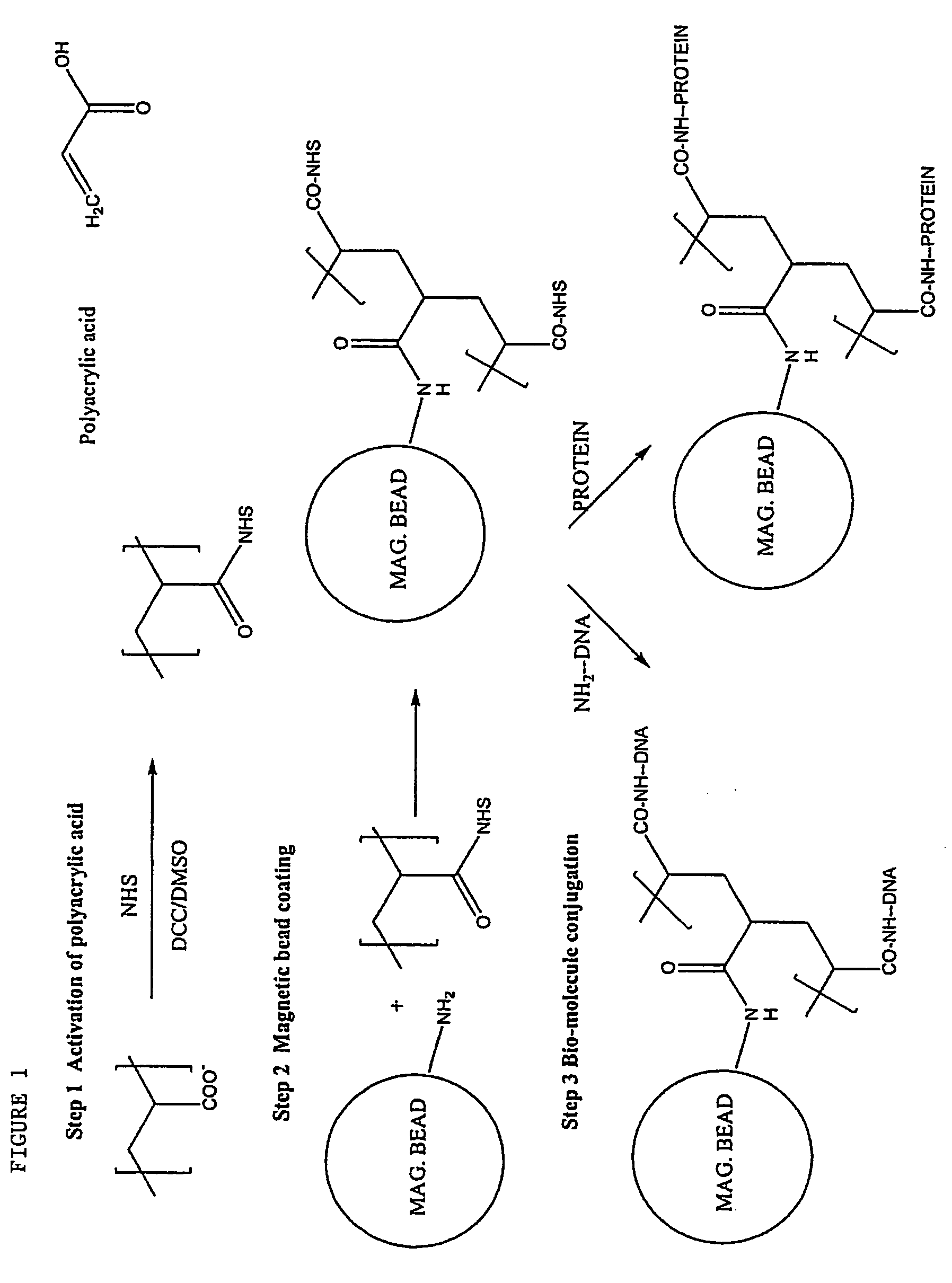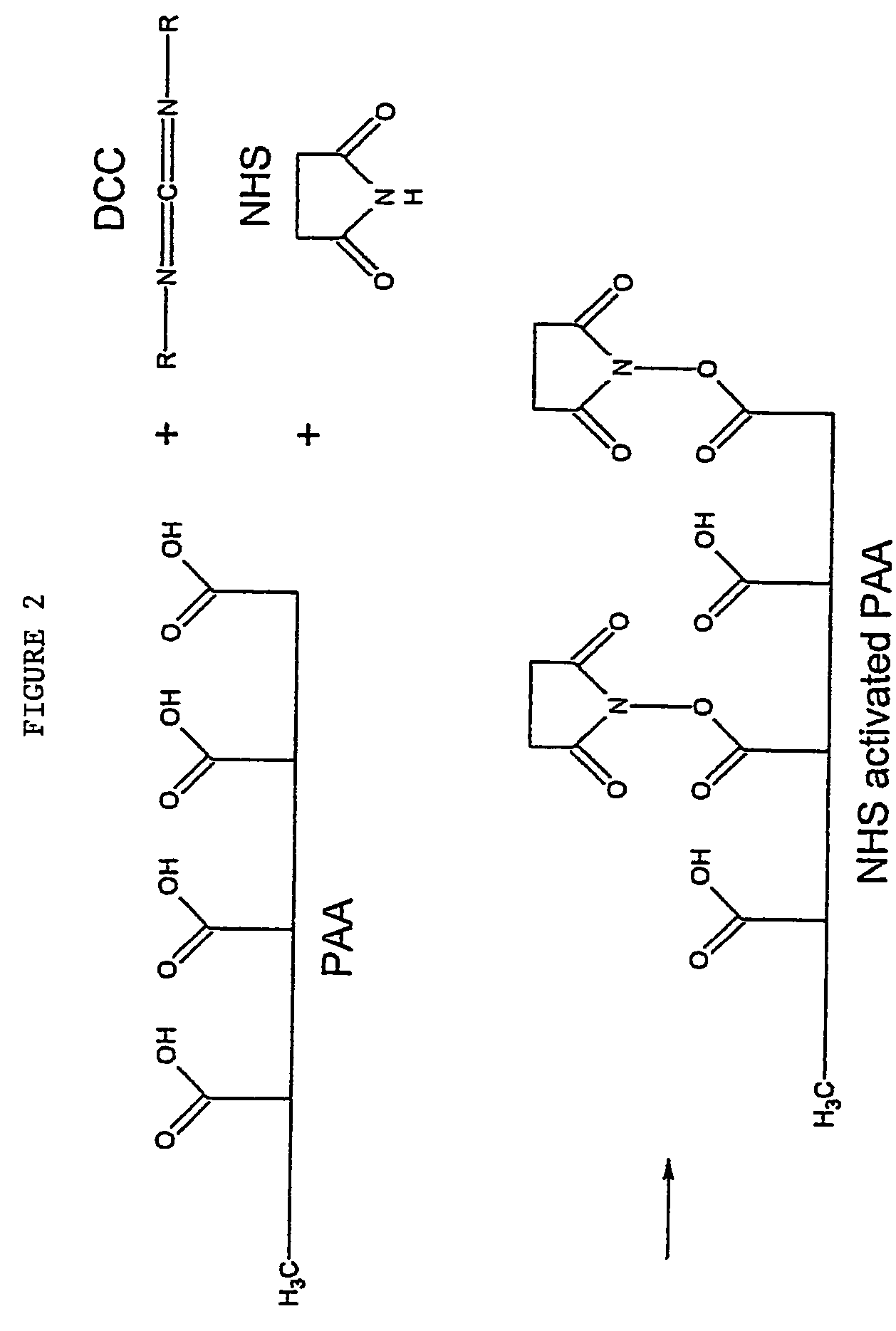Substrate functionalization method for high sensitivity applications
a functionalization method and substrate technology, applied in the field of substrates and methods for functionalizing substrates, can solve the problems of complex detection of extremely low amounts of target analytes in samples, false positives, and low association non-specific binding, so as to reduce non-specific binding and background detection, improve the effect of binding efficiency and reducing false positives
- Summary
- Abstract
- Description
- Claims
- Application Information
AI Technical Summary
Benefits of technology
Problems solved by technology
Method used
Image
Examples
example 1
Preparation of Functionalized Magnetic Beads
[0078] In this Example, a procedure is provided for preparing functionalized magnetic beads.
[0079] (a) Activation of Polyacrylic Acid
[0080] Polyacrylic acid (Aldrich, MW ˜2000) was dissolved in an 80:20 DMSO:Water mixture to give a 22% w / v solution. To 100 uL of this solution was added in succession, 600 uL of 1M solution of NHS prepared in DMSO and 600 uL of 1M solution of DCC prepared in DMSO. The solution was left overnight at RT with mild shaking. The resulting mixture containing the activated polymer and the DCC-urea precipitate was spun at 15,000 rcf for 10 min and the supernatant removed to a fresh tube. The step was repeated in order to ensure that the solution was clear of any particulate DCC-urea. Filtration to remove the DCC-urea is also an option for larger scale preparations. FIG. 2 illustrates the reaction.
[0081] (b) Coupling Activated Polymer to Amine-functionalized Magnetic Beads
[0082] Amine-functionalized magnetic bea...
example 2
Conjugation of Bio-molecules to the Magnetic Particles
[0083] In this Example, a generalized approach for the conjugation of bio-molecules to the magnetic particles is provided. See FIG. 1.
[0084] (a) DNA Coupling to the Activated Magnetic Beads
[0085] To 500 uL magnetic beads (5 mg / mL) was added 20 uL of a 0.2 mM amine-modified oligonucleotide solution and mixed vigorously on a vortex. The suspension was left overnight at RT with shaking. Finally, the beads were isolated, washed repeatedly with a wash buffer containing 50% formamide / 0.01% Tween 20 at 50° C. repeatedly and re-suspend in 500 uL 2×SSC / 15% Formamide / 0.01% Tween to yield magnetic beads at an approximate concentration of 5 ug / uL.
[0086] (b) Protein Coupling to the Activated Magnetic Beads
[0087] To 2.5 mg of magnetic beads was added 323 uL of 1× PBS, 167 uL of 3 M ammonium sulfate, and 10 uL of antibody (10 ug / uL). The solution was mixed gently on a vortex and the suspension was incubated overnight at 37° C. on a rotisse...
example 3
DNA Detection Using the Functionalized Magnetic Particles
[0090] In this Example, a nucleic acid bio-barcode assay detecting low target concentrations HBV target is described. See FIG. 3. Capture oligonucleotides specific for the HBV target were conjugated to polyacrylic acid-coated paramagnetic particles. The low non-specific binding associated with the magnetic particles and their ability to capture low target amounts allows ultra-high sensitivity at ˜15 attomolar concentration (450 copies / assay).
[0091] Polymer-coated magnetic particles were functionalized with capture oligonucleotides specific to the HBV target. The HBV target was generated by PCR-amplifying the RNA target after a reverse transcription step. The magnetic beads (7.5 ug / assay) were added to a hybridization mix (final volume 50 uL) containing different concentrations of the HBV target 3×SSC / 0.025% Tween 20 / 0.0125% SDS, 30% formamide, and 2 nM each of 17 intermediate oligos that had been previously denatured and inc...
PUM
| Property | Measurement | Unit |
|---|---|---|
| size | aaaaa | aaaaa |
| size | aaaaa | aaaaa |
| size | aaaaa | aaaaa |
Abstract
Description
Claims
Application Information
 Login to View More
Login to View More - R&D
- Intellectual Property
- Life Sciences
- Materials
- Tech Scout
- Unparalleled Data Quality
- Higher Quality Content
- 60% Fewer Hallucinations
Browse by: Latest US Patents, China's latest patents, Technical Efficacy Thesaurus, Application Domain, Technology Topic, Popular Technical Reports.
© 2025 PatSnap. All rights reserved.Legal|Privacy policy|Modern Slavery Act Transparency Statement|Sitemap|About US| Contact US: help@patsnap.com



